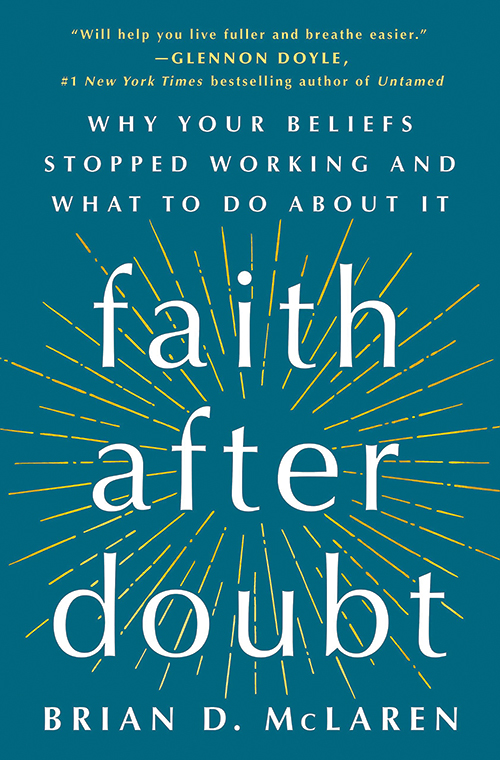
Faith After Doubt: Why Your Beliefs Stopped Working and What to Do About It
Reviewed by Marty Grundy
October 1, 2021
By Brian D. McLaren. St. Martin’s Essentials, 2021. 256 pages. $26.99/hardcover; $13.99/eBook.
Although this book is clearly written for disillusioned Evangelical Christians, there is fodder here for Friends Journal readers because the author’s stages of faith development work for any religion or any belief system about politics, economics, conspiracies, or other ideologies. It’s possible that an understanding of his stages might help us listen more carefully to folks we don’t agree with, opening ourselves to love and compassion rather than judgment.
McLaren uses a four-stage model of spiritual development—something the Friends General Conference (FGC) Religious Education Committee explored in the 1980s and early 1990s. A number of authors use stage theories of spiritual growth (helpfully compared in appendix III), and each has its own nuanced descriptions. Their purpose is not to establish a hierarchy but to help explain the different ways individuals and institutions model their expectations, as well as to describe the dynamics of change and growth. Key components of faith are traced across McLaren’s four stages in appendix I.
The author uses the metaphor of boxes. Each stage is a box, and succeeding boxes include the earlier box but are larger. One moves from one stage to the next when the box feels too small and constricting. Doubt is a major driver. The fourth box has no lid at all.
The first stage, which McLaren calls “Simplicity,” sees the world in simple, uncomplicated dualistic terms: good/bad, truth/falsehood, right/wrong—and also us/them, which can lead to exclusion, hatred, and violence. The second stage, “Complexity,” is a time of pragmatism, “what works for me,” independent faith fed by study, retreats, books, lectures, conferences, and missions. Evangelicals in this stage constitute a significant market for religious how-to and self-improvement opportunities that promise prayers will be answered, marriages healed, and prosperity assured. The lessons in this stage include a recognition that there are shades of gray between the black-and-white certainty of stage one. In time, some find stage two complexity to be shallow and the promises false.
Those desperately seeking honesty and depth move into stage three, “Perplexity”: life is strange and mysterious, and there is too much “malarkey” among authority figures—and not just those in religion. The lessons or gifts of stage three are “honesty, humility, openness, curiosity, scholarship, and a commitment to understanding the truth, no matter the cost.” But because of their experiences, stage three seekers tend to distrust and challenge institutions, suspect authority figures, embrace relativism, and are generally suspicious. So finding a stable third stage faith community is hard.
This is where some Liberal Friends find themselves, but McLaren is still talking of Evangelicals, who as they progress through stage three begin to see the problems with Christian triumphalism, colonialism, racism, homophobia, extractive capitalism, male hierarchies, etc. Stage three is “an attempt to see through false or incomplete morality to a deeper and more holistic understanding of good and evil, right and wrong.” Appendix IV has a number of resources for people struggling with doubt, including authors beloved by Friends. Religious “refugees” who have found their way to a Friends meeting might recognize these stages as steps on their own journeys.
Religious faith is supposed to provide meaning, belonging, and purpose. If we in stage three jettison religion entirely, economic, racial, or political ideologies will fill the void by offering their own meaning, belonging, and purpose. We see this in many countries today, including in the United States. Stages of faith are not just a religious phenomenon, but a human one. Recognizing them in any area of life helps us to listen with more compassion and to acknowledge the characteristics of each stage—and that change is possible.
Stage four is “Harmony,” when we can “see things without the obsessive dualistic judgments of Simplicity, without the compulsive pragmatic analyses and schemes of Complexity, and without the deconstructing suspicions of Perplexity.” “Harmony” learns to live into revolutionary love: “loving as God would love: infinitely, graciously, extravagantly.”
Acknowledging the decline of traditional churches, McLaren heralds new forms of community churches. He sketches underpinnings of religious education that allow for all four stages. New churches need not affiliate with any single denomination. Examples already exist within Protestant Christianity, Islam, and Judaism. Their hallmark is faith expressed as love rather than correct belief.
Each chapter ends with a section encouraging reflection and action; some of the queries will challenge Friends. As we hope to be open and welcoming spaces, understanding stages of faith development can help us meet people where they are with love rather than judgment. It also points to the necessity of going deeper than stage three skepticism. May we all embrace the deep yearning that our faith be expressed as love.
Marty Grundy is a member of Wellesley (Mass.) Meeting, New England Yearly Meeting. She served on FGC’s Religious Education Committee for some 15 years, and clerked its Traveling Ministries Committee for six.


